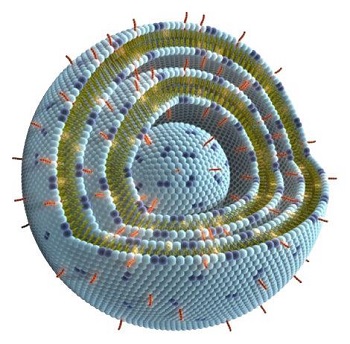 |
| Liposome used in the Stimuvax experimental cancer vaccine--Courtesy of Dr. Schimanski, et al., BMC Cancer |
Scientists have long been looking to liposomes for drug delivery, and a new contingent of researchers from Moscow and Boston published a report this week in the journal Chemical Review looking back at how far the tiny vehicles have come since their development in the 1960s and forward to where they have yet to go.
The international research team investigated several of the more important aspects of liposomal delivery, including the manufacture of the vehicles, the different structures and shapes possible and also the methods of delivery, including targeting mechanisms and release.
Liposomes are often spherical, microscopic shells made with a similar structure as a cell membrane and with some of the same functions. Most of all, with its combination of hydrophilic and hydrophobic molecular components, it allows for a separation of the liposome's contents with the surrounding environment. This makes them ideal for drug delivery as they can "protect" the drug and, in the case of cytotoxins used to fight cancer, protect healthy cells from the drug while targeting a tumor.
Vladimir Torchilin of the Moscow Institute of Physics and Technology has been working with liposomes since the late 1970s and is the main author of the new report. He joined scientists from Northeastern University in putting it together.
Beyond just drug delivery, the authors also looked forward to different uses for liposomes, including molecular imaging, vaccine delivery and analytical applications, as well as the regulatory hurdles now faced and expected down the road.
- here's the release from MIPT
- and here's the report from Chemical Review (sub. req.)